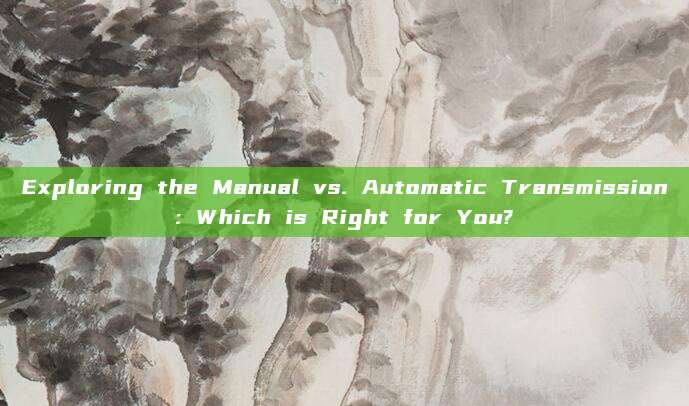Introduction:
When it comes to selecting a vehicle, one of the most crucial decisions a buyer faces is choosing between a manual or automatic transmission. Both types have their own set of advantages and disadvantages, making the choice a highly personal one. This article delves into the key differences between manual and automatic transmissions, providing insights to help you make an informed decision.

The Basics of Manual Transmission:
A manual transmission, also known as a stick shift, requires the driver to manually change gears. This involves using a clutch pedal to engage and disengage the clutch, and shifting gears using a gear lever. Despite its perceived complexity, many drivers find the manual transmission to offer greater control over the vehicle's performance.
One of the main advantages of a manual transmission is its efficiency. According to a report by the U.S. Environmental Protection Agency (EPA), vehicles with manual transmissions tend to be more fuel-efficient than those with automatics. This is because the driver can optimize gear changes to match the vehicle's speed and engine RPM, resulting in better fuel economy.
Another benefit of a manual transmission is its affordability. Manual vehicles often come at a lower price point than their automatic counterparts, making them an attractive option for budget-conscious buyers.
Understanding Automatic Transmission:
Automatic transmissions, on the other hand, automate the gear-shifting process. They use a torque converter and a series of clutches to automatically select the appropriate gear based on the vehicle's speed and engine load. This eliminates the need for a clutch pedal and gear lever, making driving easier for those who prefer a hands-free experience.
The convenience of an automatic transmission is one of its most significant advantages. Drivers can focus on other aspects of driving, such as navigation and passenger interaction, without the need to constantly monitor and change gears.
According to a study by J.D. Power, 80% of new car buyers in the United States prefer automatic transmissions. This preference is primarily driven by the convenience and ease of use that automatics offer.
Performance and Reliability:
While both manual and automatic transmissions have their own strengths, the choice between them often comes down to personal preference and driving style. Manual transmissions tend to offer better performance in terms of acceleration and handling. This is because the driver can control gear changes to optimize the vehicle's performance.
In terms of reliability, both types of transmissions have a long track record of dependability. However, manual transmissions may require more maintenance, such as clutch replacement and regular oil changes, compared to automatics, which have fewer moving parts.
Cost of Ownership:
The cost of ownership is another important factor to consider when choosing between manual and automatic transmissions. Manual vehicles often have lower maintenance and repair costs due to their simpler design. However, the upfront cost of a manual transmission vehicle may be lower, which can make a significant difference in the long run.
According to a report by Kelley Blue Book, the average cost of repairs for a manual transmission vehicle is approximately $500 per year, compared to $700 for an automatic.
Conclusion:
Ultimately, the decision between a manual and automatic transmission comes down to personal preference, driving style, and budget. Manual transmissions offer better performance and fuel efficiency, while automatics provide greater convenience and ease of use. By understanding the differences between these two types of transmissions, you can make an informed choice that best suits your needs and driving habits.









